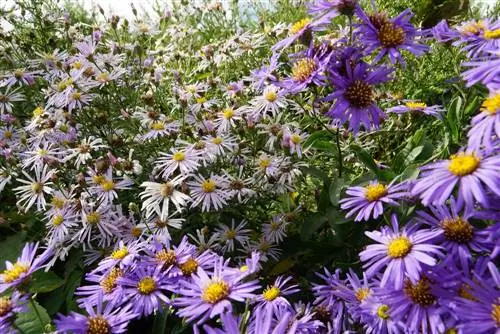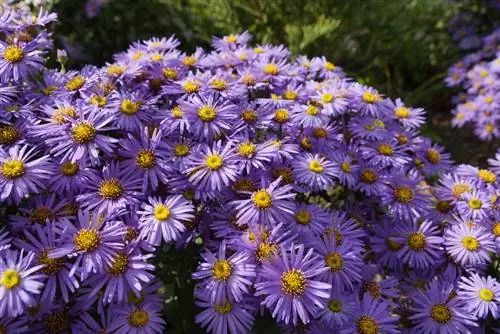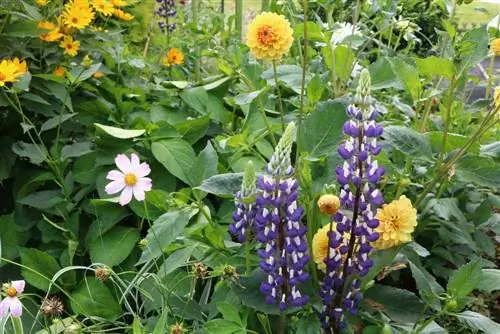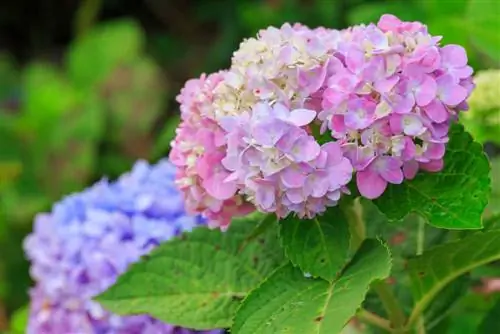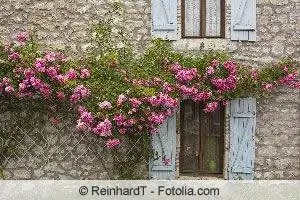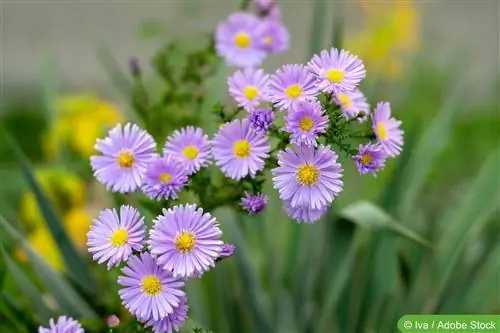- Author admin [email protected].
- Public 2023-12-17 03:39.
- Last modified 2025-01-24 12:45.
Who doesn't know the small, indestructible Alpine aster? It has many names such as blue chamois root, alpine starflower or blue mountain starwort and is certainly traded under these names in other regions. In principle, the Alpine aster belongs to the aster genus, even if they are smaller in appearance than the well-known aster species. This small plant rightly bears the name Alpine aster, because its ancestral homeland is the Alps, the Tatra Mountains and the Pyrenees. You can even find this little beauty in the Balkans and Asia. It still grows at an altitude of 3000 meters, where it prefers dry and warm soils. They are often found in association with the edelweiss. What you should definitely know is that in Germany these small plants are protected by the Federal Species Protection Ordinance and are therefore under species protection.
The Alpine aster in our gardens
Nevertheless, gardening enthusiasts do not have to miss out on this beautiful addition to their garden, because the Alpine aster is also available as a cultivated garden plant. This also has the characteristic features of the real Alpine aster. This plant is best suited to rock gardens, as it could easily be overlooked due to its low growth. In principle, the Alpine aster is an undemanding and easy-care plant that loves to be in a sunny spot. Ideally near a larger stone that can still give off heat even after the sun has set. The small plant can grow between 10 and 25 cm tall and, due to its size, fits perfectly into the landscape of a rock garden. Their bushy and compact growth also tends to form cushions, so over time you get pretty little carpets. If the Alpine aster is combined with other types of aster, beautiful contrasts can be achieved. The asters should be planted in small tuffs, which may be in different colors.
A little description of plants
It is already known that the plant does not grow very large. But if you want to bring the Alpine aster into your garden, you can in principle compare it well with the wild form. The only difference is that the wild form always beautifies the mountain meadows with blue flowers, while the cultivated species can appear in different colors. The “Albus” variety has pure white flowers, while the “Dark Beauty” has strong violet colors and the “Happy End” blooms pink. But they all have one thing in common: they have a yellow center. The flowering period of the Alpine aster begins in May and ends in mid to late September. The Alpine aster has medium green leaves that are narrow and elongated. They may also have slight hairiness. The pointed leaves are a beautiful contrast to the colorful flower wreaths. In order for the Alpine aster to bloom particularly beautifully, the soil must be suitable for the plant. The Alpine aster needs a permeable, calcareous soil that can be sandy or stony. But it shouldn't be too dry. It goes without saying that you also have to water the Alpine aster. It is important to ensure that the soil does not dry out.
Care and propagation
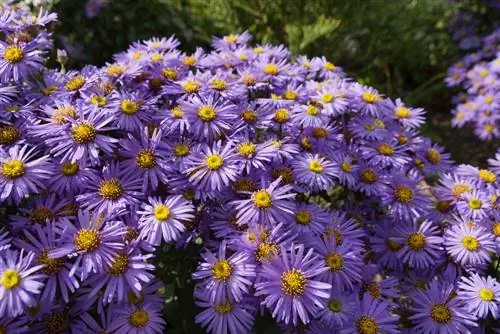
The first question you always ask yourself is, when is the best time to plant the Alpine aster? The gardener says the Alpine aster can be planted at any time as long as the ground is not yet frozen. During the vegetation phase you should remove the withered stems and cut them down to the ground. A somewhat vigorous pruning should be carried out either in late autumn or in early spring before the plant sprouts again. Since the Alpine aster forms small cushions over the years and continues to expand, at some point it becomes necessary to divide it. This division should be carried out every two to four years. This means that the Alpine aster always remains “young”. This division is also recommended by garden centers because it is known that the Alpine aster begins to age between 3 and 4 years of age. Bare spots in the upholstery look unsightly and give the impression that the plant is ailing. And who wants to have these unsightly plants in their garden? So you should keep in mind that these maintenance measures will always be necessary. What is the best way to proceed and how should a professional division be carried out?
You take a spade and carefully lift the entire nest out of the ground. Then this nest is pierced in the middle with the spade. You should therefore make sure that the spade has a sharp edge so that the horst is penetrated with the first blow. If the spade is blunt, the roots will only be bruised and will rot. Once you have divided the clump, use your hands to break these clumps into pieces that are approximately the same size but still have enough roots.
Time for the new plantings
The places intended for new planting can still be treated with new soil and some fertilizer. Pour the soil a little and let the water seep away. A small divided plant part is inserted into this moist hole in the ground and the soil is pressed firmly. The plant is then watered well. The watering can be a little heavy so that the soil can close well around the roots. The new plants can then beautify new spots in the rock garden or take a place on a new dry stone wall. The small Alpine asters can even be planted in wall joints. This is how you can decorate your rock garden wonderfully. If you want to plant different colored Alpine asters, they can also be grown in pots or you can plant the little beauties on the edge of borders, where they also have a great effect. Alpine asters are a very popular source of nectar for bees, bumblebees and butterflies. If you enjoyed your little asters all summer, you should cover them with some winter protection in the winter. So they will unfold their little splendor again next spring.
Profile
- Species/Family: Perennial. Belongs to the daisy family (Asteraceae)
- Care effort: Low. Undemanding and easy to care for
- Flowering time: Depending on the variety, May to September with typical flowers in white, pink or violet and usually a yellow center
- Foliage: Elongated, narrow, pointed towards the front, hairy leaves in medium green
- Growth: Bushy, compact growth with cushion formation
- Height: 5 to 25cm
- Location: Sunny to partially shaded, with sunny being preferred. Likes to sit on stones that give off heat. Permeable, sandy, calcareous, not too dry, also stony soil
- Planting time: Any time as long as the ground is not frozen
- Pruning: Prune in late autumn or spring before new growth
- Partner: Pretty with other types of aster and in tuffs with several plants
- Propagation: Division in early spring or after flowering
- Care: Water when dry, soil should not dry out completely
- Wintering: Is grateful for some winter protection
Special features
- Is native to the European Alps, the mountains of Asia and North America
- Wild form is protected
- Is considered a short-lived perennial, as it ages after approx. 3-4 years and should be rejuvenated (see also rejuvenating Alpine aster below)
- Nectar dispenser, particularly popular with butterflies, but also bees and bumblebees
- Can also be kept as a container plant
- Fits well in the rock garden and on the dry stone wall, even in wall joints
Varieties (selection)
- `Albus: Pure white flowers
- `Dark Beauty: Strong purple flowers with a yellow center
- `Happy Ending: Blooming Pink
Rejuvenate Alpine Aster
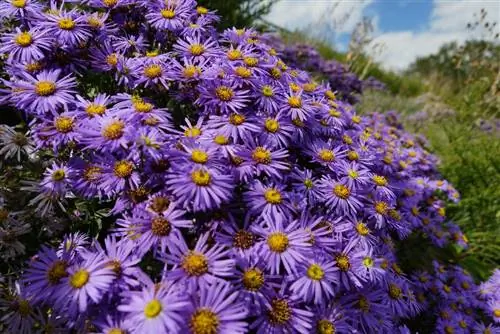
The entire nest is carefully lifted out of the ground with the spade and then divided in the middle with the spade blade. The spade blade should therefore be sharp. Individual pieces of approximately the same size are removed with your hands and replanted, whereby the new substrate should be prepared with a little fertilizer. To improve growth, water thoroughly so that the roots get proper contact with the soil.

